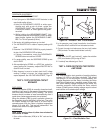
SSeeccttiioonn 77
DDIIAAGGNNOOSSTTIICC TTEESSTTSS
Excitation Circuit Breaker (CB3). Connect one test lead to one
end of Wire 2A and the other test lead to the other end of the
same wire. The meter should read continuity.
RESULTS:
If continuity was NOT measured across each wire,
repair or replace the wires as needed.
If continuity WAS measured, proceed to Test 6.
TEST 6- CHECK FIELD BOOST
DISCUSSION:
Field boost current is delivered to the Rotor only while
the engine is being cranked. This current helps
ensure that adequate “pickup” voltage is available to
turn the Voltage Regulator on and build AC output
voltage.
Loss of the field boost function may or may not result
in a problem with AC output voltage. If the Rotor's
residual magnetism is sufficient to turn the Regulator
on, loss of the function may go unnoticed. However, if
the Rotor's residual magnetism is not enough to turn
the Regulator on, loss of field boost can result in fail-
ure of the unit to generate an output voltage.
PROCEDURE:
1. Set VOM to measure DC voltage.
2. Disconnect Wire 4 from the Voltage Regulator and connect the
positive (+) test lead to it. Connect the negative (-) test lead to
a clean frame ground.
3. Set the Start-Stop Switch to “START.” During cranking only,
measure DC voltage. It should read 3-5 VDC. Reconnect Wire
4 to the Voltage Regulator. If voltage is measured, it can be
assumed that the Field Boost is working. Stop testing. If volt-
age is not measured, proceed to Step 4.
4. Connect the positive (+) test lead to Wire 16 at pin location J1-
13 on the PCB (see Figure 7-4) (J1, J2 & J3 connectors remain
connected to PCB). Connect the negative(-) test lead to a
clean frame ground.
5. Set the Start-Stop Switch to “START.” During cranking only,
battery voltage should measure 11-12 VDC.
6. Connect the positive (+) test lead to Wire 4 at pin location J1-9
on the PCB (see Figure 7-4) (J1, J2 & J3 connectors remain
connected to PCB). Connect the negative(-) test lead to a
clean frame ground.
7. Set the Start-Stop Switch to “START.” During cranking only
measure the DC voltage. It should measure 3-5 VDC.
RESULTS:
1. If battery voltage was not measured in Step 5, repair or replace
Wire 16 between the Starter Contactor Relay and PCB.
2. If field boost voltage was measured in Step 7 but not measured
in Step 3, repair or replace Wire 4 between PCB and Voltage
Regulator.
3. If battery voltage was measured in Step 5 but field boost volt-
age was not measured in Step 7, replace PCB.
4. If field boost checks good, replace the Voltage Regulator.
Figure 7-4. – The Field Boost Circuit
TEST 7 - TEST STATOR DPE WINDING
DISCUSSION:
An open circuit in the Stator excitation windings will
result in a loss of unregulated excitation current to the
Voltage Regulator. The flow of regulated excitation cur-
rent to the Rotor will then terminate and the unit's AC
output voltage will drop to a value that is commensurate
with the rotor’s residual magnetism (about 5 - 12 VAC).
Figure 7-5. – Stator Excitation Winding
Page 41


















